Australia
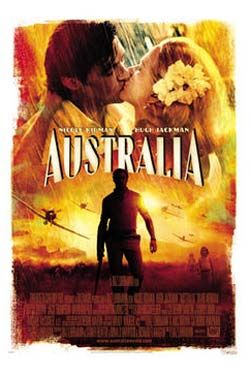
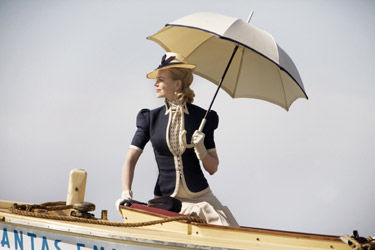 If you're going to expect audiences to sit through a movie that runs for nearly three hours, there has to be something there in the story. Everything here is either overly calculated, or meandering to the point of near-madness. After a while, the grandeur of the visuals wears thin, and we start looking toward the characters to supply us with emotional attachment. The uneven script opens in 1939, and tells the story of Sarah Ashley (Nicole Kidman), a British aristocrat who heads for Australia to be with her husband, who is currently trying to turn the luck of a cattle ranch called Faraway Downs around. Her husband is murdered before she can arrive, and so Sarah finds herself inheriting the land and the workers. In order for the ranch to survive, she must sell the cattle to the military stationed in Darwin. The main supplier of beef and cattle in Darwin, the Carney Cattle Company, has been intentionally sabotaging the Faraway Downs ranch, hoping to buy the land for its own purposes. Not wanting to lose to the oily King Carney (Bryan Brown) or his son Fletcher (David Wenham), Sarah decides to make the treacherous cattle drive herself with the aid of a grizzled cowboy named Drover (Hugh Jackman), and a young Aborigine boy named Nullah (Brandon Walter) who lives on the ranch in secret, since he is a half-breed or "creamy", and would be sent to Missionary Island if anyone discovered him.
If you're going to expect audiences to sit through a movie that runs for nearly three hours, there has to be something there in the story. Everything here is either overly calculated, or meandering to the point of near-madness. After a while, the grandeur of the visuals wears thin, and we start looking toward the characters to supply us with emotional attachment. The uneven script opens in 1939, and tells the story of Sarah Ashley (Nicole Kidman), a British aristocrat who heads for Australia to be with her husband, who is currently trying to turn the luck of a cattle ranch called Faraway Downs around. Her husband is murdered before she can arrive, and so Sarah finds herself inheriting the land and the workers. In order for the ranch to survive, she must sell the cattle to the military stationed in Darwin. The main supplier of beef and cattle in Darwin, the Carney Cattle Company, has been intentionally sabotaging the Faraway Downs ranch, hoping to buy the land for its own purposes. Not wanting to lose to the oily King Carney (Bryan Brown) or his son Fletcher (David Wenham), Sarah decides to make the treacherous cattle drive herself with the aid of a grizzled cowboy named Drover (Hugh Jackman), and a young Aborigine boy named Nullah (Brandon Walter) who lives on the ranch in secret, since he is a half-breed or "creamy", and would be sent to Missionary Island if anyone discovered him.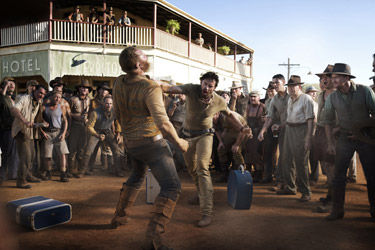 During the course of the cattle drive, Sarah and Drover develop a supposedly close relationship, even though the movie never quite delves as deep as it probably should. We get a lot of impressive shots of the open landscape of Australia, and an equally impressive action sequence where the evil Fletcher and his men set a stampede, and Sarah, Drover and their group must prevent the cattle from running wild. But, the movie meanders most of the time here. It never quite finds sure footing, and its tone seems to change scene to scene. The early moments between Sarah and Drover are treated like a mischievous romantic comedy, and the narration by young Nullah hints that the movie will have a whimsical and charming tone. But it never lives up to that promise. It never finds a consistent tone, nor does it figure out how to endure these characters to its audience. The relationship that builds between Sarah and Drover is contrived, instead of natural. They fall in love not because of scenes they share together, but because they are the stars of the movie. The movie takes the easy way out, and sets most of their bonding off camera, or in brief montage sequences.
During the course of the cattle drive, Sarah and Drover develop a supposedly close relationship, even though the movie never quite delves as deep as it probably should. We get a lot of impressive shots of the open landscape of Australia, and an equally impressive action sequence where the evil Fletcher and his men set a stampede, and Sarah, Drover and their group must prevent the cattle from running wild. But, the movie meanders most of the time here. It never quite finds sure footing, and its tone seems to change scene to scene. The early moments between Sarah and Drover are treated like a mischievous romantic comedy, and the narration by young Nullah hints that the movie will have a whimsical and charming tone. But it never lives up to that promise. It never finds a consistent tone, nor does it figure out how to endure these characters to its audience. The relationship that builds between Sarah and Drover is contrived, instead of natural. They fall in love not because of scenes they share together, but because they are the stars of the movie. The movie takes the easy way out, and sets most of their bonding off camera, or in brief montage sequences.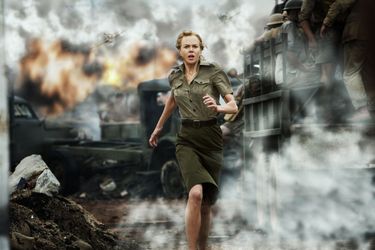 For the third act, the film plunges right into the early days of World War II, with Japanese fighter planes approaching mere months after bombing Pearl Harbor. The movie tries to build tension by separating the three heroes. Little Nullah has been discovered and sent to Missionary Island (which is in danger of being the first place the planes will bomb), Sarah is trying to get to Nullah so that they can be together, and Drover has gone off, pretending he doesn't care, but we know he does because he's the rugged hero. (He only left in the first place, because he holds a lot of painful memories of when his wife died, and doesn't know how to open up in relationships.) The tension is supposed to be supplied by the fact that these three characters are trying to get to each other, and information is limited as the attacks start up, so they often don't know if the ones they're looking for are even alive. Once again, the fact that we don't know these characters very well dampens the dramatic impact. The visuals of the planes diving and bombing the landscape is occasionally breathtaking, but there is no emotional center. It's simply an undercooked romantic melodrama set against a historic backdrop. The fact that it takes place during World War II has little consequence. If you think this sounds a little like Michael Bay's Pearl Harbor film, you wouldn't be too far off.
For the third act, the film plunges right into the early days of World War II, with Japanese fighter planes approaching mere months after bombing Pearl Harbor. The movie tries to build tension by separating the three heroes. Little Nullah has been discovered and sent to Missionary Island (which is in danger of being the first place the planes will bomb), Sarah is trying to get to Nullah so that they can be together, and Drover has gone off, pretending he doesn't care, but we know he does because he's the rugged hero. (He only left in the first place, because he holds a lot of painful memories of when his wife died, and doesn't know how to open up in relationships.) The tension is supposed to be supplied by the fact that these three characters are trying to get to each other, and information is limited as the attacks start up, so they often don't know if the ones they're looking for are even alive. Once again, the fact that we don't know these characters very well dampens the dramatic impact. The visuals of the planes diving and bombing the landscape is occasionally breathtaking, but there is no emotional center. It's simply an undercooked romantic melodrama set against a historic backdrop. The fact that it takes place during World War II has little consequence. If you think this sounds a little like Michael Bay's Pearl Harbor film, you wouldn't be too far off.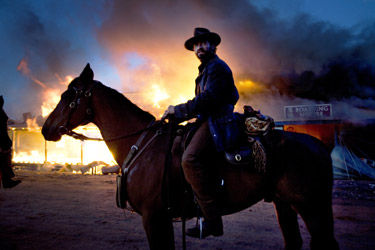 And that's the problem. Instead of truly exploring its setting or its own ideas, Australia is content to simply recycle an age old love story with a fresh coat of visual paint. This was intentional, as co-writer and director Luhrmann has stated he based his characters on classic film roles. Unfortunately, Sarah and Drover don't have half the life or personality as the characters they're modeled after. For example, Sarah is supposed to be modeled after Katherine Hepburn's character in The African Queen. But Nicole Kidman lacks the charm of Hepburn's classic performance. She's a typical spoiled aristocrat cliche who is supposed to go through a transformation for the better because of her experiences, but she never turns into a very interesting character. Likewise, Jackman's Drover is a surprising bore. Yeah, he's rugged and handsome, but he seems to have no real personality or motivations other than to look rugged and handsome. Both Kidman and Jackman have impressed me many times in the past, and they're certain to again. Here, they're stuck with character descriptions instead of genuine personalities. It's as if Luhrmann gave both of them one or two basic character traits, and then told them to build their entire performances around that. There's no heart behind their performances.
And that's the problem. Instead of truly exploring its setting or its own ideas, Australia is content to simply recycle an age old love story with a fresh coat of visual paint. This was intentional, as co-writer and director Luhrmann has stated he based his characters on classic film roles. Unfortunately, Sarah and Drover don't have half the life or personality as the characters they're modeled after. For example, Sarah is supposed to be modeled after Katherine Hepburn's character in The African Queen. But Nicole Kidman lacks the charm of Hepburn's classic performance. She's a typical spoiled aristocrat cliche who is supposed to go through a transformation for the better because of her experiences, but she never turns into a very interesting character. Likewise, Jackman's Drover is a surprising bore. Yeah, he's rugged and handsome, but he seems to have no real personality or motivations other than to look rugged and handsome. Both Kidman and Jackman have impressed me many times in the past, and they're certain to again. Here, they're stuck with character descriptions instead of genuine personalities. It's as if Luhrmann gave both of them one or two basic character traits, and then told them to build their entire performances around that. There's no heart behind their performances.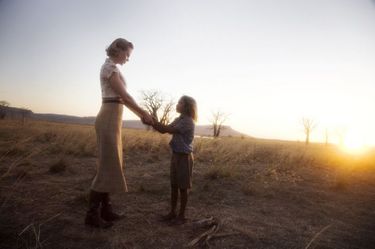 If it had been done right, Australia could have been a magical and sweeping movie. The film obviously wants us to be swept away in its epic romance, but the uninteresting characters at the core of that romance hold us back. When the lovers are brought together or torn apart, the movie seems to be trying its hardest to generate emotion, but we don't react. Even a hopelessly romantic tale such as this needs some substance. The climax of the film is a key example of just how this thing goes wrong. It's a convoluted set up built around reunions, chance circumstances, attempted murder, and contrived heroics by a character who's been watching from the outside the entire time, only to suddenly step in at just the right moment and prevent disaster. It's the kind of ending that's supposed to have us cheering, but I was left shaking my head. It's not that I'm a cynic. After all, Lurhmann's Moulin Rouge used many of the same melodramatic elements this film does, and I thoroughly enjoyed it. But here, because we have no involvement with anything except the scenery, it seems cornball.
If it had been done right, Australia could have been a magical and sweeping movie. The film obviously wants us to be swept away in its epic romance, but the uninteresting characters at the core of that romance hold us back. When the lovers are brought together or torn apart, the movie seems to be trying its hardest to generate emotion, but we don't react. Even a hopelessly romantic tale such as this needs some substance. The climax of the film is a key example of just how this thing goes wrong. It's a convoluted set up built around reunions, chance circumstances, attempted murder, and contrived heroics by a character who's been watching from the outside the entire time, only to suddenly step in at just the right moment and prevent disaster. It's the kind of ending that's supposed to have us cheering, but I was left shaking my head. It's not that I'm a cynic. After all, Lurhmann's Moulin Rouge used many of the same melodramatic elements this film does, and I thoroughly enjoyed it. But here, because we have no involvement with anything except the scenery, it seems cornball.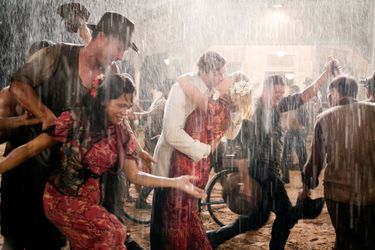
See the movie times in your area or buy the DVD at Amazon.com!






0 Comments:
Post a Comment
<< Home